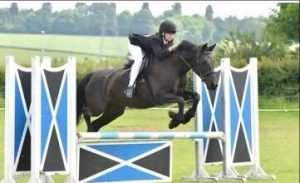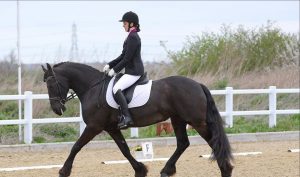Tips & Tricks
General Showing Guidelines – In Hand
You can download this information here:
Before the Show
- Get horse/pony as clean as possible
- Practise before going in the ring (basically run round a bit and get horse listening to you)
- Practise getting your horse to stand still and square
At the Show/In the Class
- The ring steward will let you in the ring
- The horse will be on the right rein for most of the time – you leading him on the outside of the ring, this allows the judge the best view of your animal
- The judge will ask you to walk round the ring
- The steward will then stop you, usually in a queue up to the corner of the ring. One by one you will be required to run with your horse in trot around half if not all of the arena. When that’s done all of you will walk round again. At this point you will be pulled into a line up – sometimes this is any old how, sometimes you will be pulled in in an initial order going from left to right
- One by one the judge will ask you to bring you horse forward. You may be asked questions such as how old the horse is, breed and what you do with him
- Whilst the judge is asking questions get your horse to be standing square – this is where the judge will have a good look at its
- When they’ve seen enough they will ask you to walk away from them turning to the right at a set point (usually the end of the ring) and then trot back
- When everyone’s been judged individually you will then be asked to walk around the ring again while the judge makes his mind up
- Then the judge will pull you in in the order of placing, i.e. the first competitor gets pulled in first
What to Wear
Horse
- In Hand Bridle (or plain snaffle bridle)
- White halter for Welsh/Fell/Dales
- No numnah/saddlecloth
- No boots/bandages
- Plaited if required (depends on breed)
Handler
- Beige trousers with the black legged ones / black trousers with the pale legged ones or Canary/corn/beige jods
- Tweed jacket / or a waistcoat (doesn’t have to be tweed)
- Shirt and tie
- Velvet hat (or velvet hat silk)
- Long hair tied back
- Short black boots/comfy shoes that you can run in
- Show cane (optional)
- Brown gloves (optional)
Please note each judge will judge slightly differently, so please use this as a guideline only
General Showing Guidelines – Ridden
Before the Show
- Get horse/pony as clean as possible
- Prepare an individual show (including walk, trot and canter on both reins and a figure of eight/change of rein, gallop down the long side)
- Practise before going in the ring
- Practise getting your horse to stand still and square
At the Show/In the Class
- The ring steward will let you in the ring
- As a group walk, trot then canter on one rein
- As a group you will normally then come back to trot, change rein, and canter on as a group again
- Then back to walk and either will be told to line up any order or pulled in in initial places
- One by one the judge will ask you to bring you horse forward. You may be asked questions such as how old the horse is, breed and what you do with him
- Whilst the judge is asking questions get your horse to be standing square – this is where the judge will have a good look at it
- When they’ve seen enough they will ask you to start your individual show
- When everyone’s been judged individually you may then be asked to walk around the ring again while the judge makes his mind up
- Then the judge will pull you in in the order of placing, i.e. the first competitor gets pulled in first
- Sample Individual Show – walk out of line and normally will face right, stand up in front of judge, (say good morning!) When judge is ready, walk away. I normally walk for a few paces, then into trot (as if on the long side) then continue (as if around a school) down the next long side, canter right in corner, half circle, trot across diagonal, then canter left half circle, extend along the back (or front) depending which way you are facing Halt, salute, back into line
What to Wear
Horse
- Snaffle Bridle or Double Bridle (depending on class)
- No boots/bandages
- Numnah’s are permitted but must be fitted and blend in to saddle i.e. black or brown Plaited/trimmed if required (depends on breed/class)
Rider
- Beige/Canary Yellow Jodhpurs
- Tweed jacket for mountain and moorland ridden and black or blue for horses
- Shirt and tie
- Velvet hat (or velvet hat silk)
- Long hair tied back
- Long Riding Boots (jodhpur boots & clips for children)
- Show cane (optional)
- Brown gloves (optional)
Please note each judge will judge slightly differently, so please use this as a guideline only.
Jumping Tips

Preparation
- Warm your pony up properly in the practice ring including jumping a couple of jumps as preparation
- Remember to pass left to left in the practice ring and let other compeitors know when you are jumping a practice fence
- Walk the course as you are planning on riding it, remembering to check you know where the start and finish markers are
- Watch a couple of competitors jump the course to see how it rides
In the Class
- The ring steward will let you in the ring
- Ride round the arena ensuring you go past the judges so they can see your competitor number
- Wait until the bell has rung indicating you can start your round. If you start before the bell you will be eliminated
- Ensure you go through the start markers
- On completion of your round ensure you go through the finish markers before leaving the arena
- For a Table A7 round, once you have completed your round, if you have gone clear, once all competitors have jumped their first round there will be a drawn order jump off which will be over a shortened timed course to assign placings as fasted clear round wins
- For a Two Phase round, once you have completed the first section (untimed) you will continue onto the second section which will be timed. The second section faults and time will determine the placings
- At the end of the class competitors who are placed will be invited into the ring to collect their prizes
What to Wear
Horse
- Bridle
- Saddle
- Martingale – Standing or running (optional). Standing martingales must be attached to a cavesson noseband
- Numnah/Saddlecloth (optional)
- Tendon/Fetlock Boots (optional)
Rider
- Show jacket
- Breeches/Jodhpurs – white/beige/yellow or fawn coloured
- Riding Hat to the current safety standard
- Shirt in white or pastel colour
- Tie or stock
- Horse Riding Boots – Traditional style riding or jodhpur boots should be worn. Plain black or brown leather gaiters cut in the traditional riding boot style can also be worn
- Gloves/Back protectors are optional but recommended
- Jump whip must not exceed 75cm and be of the new flat design as of 2020 new rules
Dressage Tips

Learn And Practice Your Test
Even if you have a caller on the day, learn the test beforehand, practice riding individual parts of the test and ride the whole test a couple of times. Don’t practice riding the whole test too many times or your horse may anticipate movements on the day. On a windy day and/or with a lot of background noise you don’t want to be left wondering where to go if you can’t hear your caller – think of the caller as a backup against forgetting the test on the day, but don’t be totally reliant on them.
Relax
Take a few deep breaths and relax your body before entering the arena. A tense rider will make a tense horse. Remember it is supposed to be fun!
Look Up
Look up and ahead of you so you can plan and prepare for your transitions and turns – it also helps with your posture and position. If you need to look down then do so with your eyes but not your head.
Ride Forward On Straight Lines
Ensure your horse is going actively forward in an even rhythm (but not rushing) on the straight lines as a horse that is lacking impulsion as you ride down the centre line or across the school is more likely to drift from side to side.
Prepare For Transitions
Half halt before each upward and downward transition to prepare your horse for the transition and help to keep it balanced through the transition.
Give Yourself More Time When Riding Transitions Between Markers
Ask for the transition 2-3 strides after your horse has passed the first marker so the judge can see that you are clearly past the first marker whilst you allow your horse the maximum amount of time to respond to your aids for the transition before reaching the second marker. If you ask for the transition half way between the markers or as you approach the second marker you give your horse less time to respond to your aids and run the risk of performing the transition too late if your horse is slow to respond.
Prepare For Turns
Half halt before each turn across the arena to prepare your horse for the turn and keep the inside leg close and pushing into the outside rein contact as you turn to prevent the horse falling in and help it balance through the turn. Look ahead of you around your turn.
Ride Good Circles
Picture the circle drawn on the arena surface and ride along its imaginary line and look 1/4 to 1/2 circle ahead as you ride to ensure you ride a good even circle.
Ride A Good Free Walk
The free walk carries double marks and the judge is looking for a good stretch down with the neck and a longer stride. Keep your hands low to encourage stretching down of the neck as you allow the horse to take the reins forward and let them slip through your fingers. Do not just throw the reins away and drop the contact altogether, the horse must take the contact forward. Alternate squeezing with each leg as each side of the horse’s body swings down to encourage a longer, active stride.
Don’t Cut Corners
Ride into the corners (but not too deep that your horse loses impulsion, rhythm and balance) as you ride around the arena. There should be a clear difference between riding a corner as you ride around the arena, to riding past the corner when riding a circle at A or C.
Bend Correctly
Ensure your horse is bent to the inside on circles, corners and turns. If your horse falls in on circles, corners or turns then half halt and push the horse with your inside leg into your outside rein contact whilst keeping the horse bent to the inside. Don’t be tempted to pull the horse out with your outside rein as this will cause the horse to bend to the outside.
Ride A Straight Halt
As you ask for halt keep your legs close to the horse’s body ready to squeeze and block with either leg if you feel the horse start to swing its hindquarters to one side as you halt.
Lastly: Enjoy yourself and have a good time!
